7201 Core Skills
Introduction (22 mins and 02 secs):
- Grip and Strike: This skill focuses on the correct way to handle and activate the tuning forks. The specific method of gripping and striking is vital for achieving the desired therapeutic effect.
- Palpation: This involves assessing the client’s body by touching and feeling for abnormalities or fluid pressure pockets. It’s crucial for determining the exact placement of the tuning forks.
- Pressure and Placement: Understanding how much pressure to apply and where to place the tuning fork is critical. This skill ensures that the vibrations reach the right depth and area for maximum therapeutic benefit.
- Feedback Mechanisms: Using your fingers to feel the changes underneath the skin while the tuning fork is vibrating. This skill is important for real-time assessment of the therapy’s effectiveness.
- Healer Logic: This involves the overall understanding and approach to therapy, including client interaction, setting session expectations, and prioritizing treatment based on the client’s conditions.
- Press and Push: This technique is about manipulating fluids in the body, helping to spread them out for easier processing by the lymphatic system.
- Gem Foot Slide: A specific technique using gem feet, primarily around the head and neck area, to assist in fluid movement. It’s an alternative for therapists who may have restrictions on direct hand contact due to licensing requirements.
- Resolution and Accountability: Ensuring that the therapy addresses the client’s issues effectively. This skill involves setting realistic goals for each session and striving for immediate pain relief or improvement.
- Adaptability in Skill Application: Understanding that the core skills are interrelated and may need to be adapted based on each session’s unique requirements.
- Long-Term Sustainability for Therapists: Developing methods and grips that prevent physical strain on the therapist, ensuring their ability to perform VFRT over long periods.
Each of these skills is integral to the success of VFRT and requires careful development and practice. Ignoring or under developing any one of these skills can significantly impact the therapy’s effectiveness. The approach you’ve outlined emphasizes not only the technical aspects of VFRT but also the importance of understanding the body’s response to treatment, therapist-client interaction, and the overall philosophy behind the therapy.
Grip and Strike (25 mins and 30 secs):
Generally, the Palpation Core Skill (discuss later) will directly precede the action of griping the tuning fork with a striking grip then striking against one of the two body locations in preparation for placement on a designated location. The Grip Core Skill is vital for both a proper strike and ability to provide the grip strength for the necessary pressure required for a vibrational fascia release.
Striking Grip
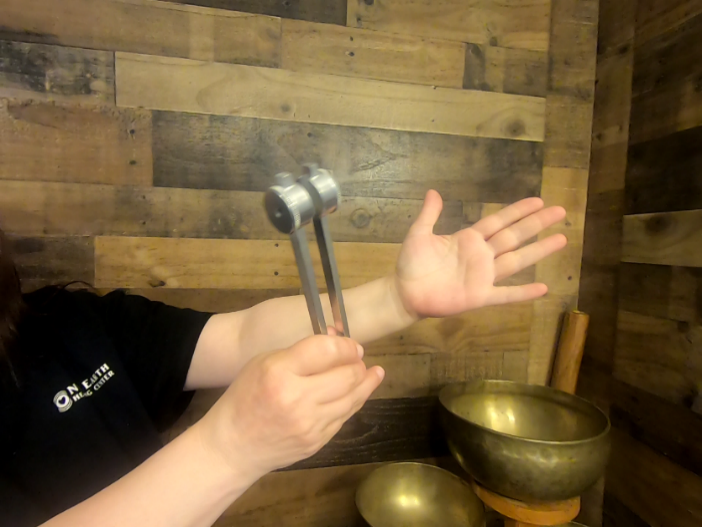
With a striking grip, we focus on holding the tuning fork for striking against a surface such as the hand or knee. Grips for striking are designed to prevent or reduce repetitive injury of the therapist while also providing a more effective grasping area on the yolk of the tuning fork instead of the stem where other practitioners tend to strike and hold the tuning fork.
Reverse Grip
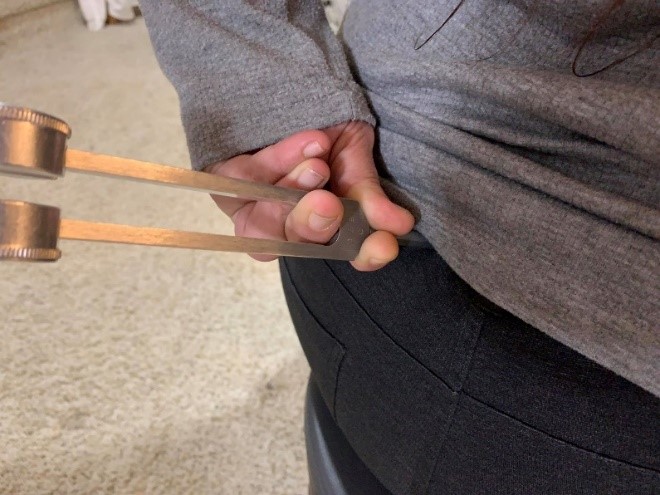
Finger Assist Grip
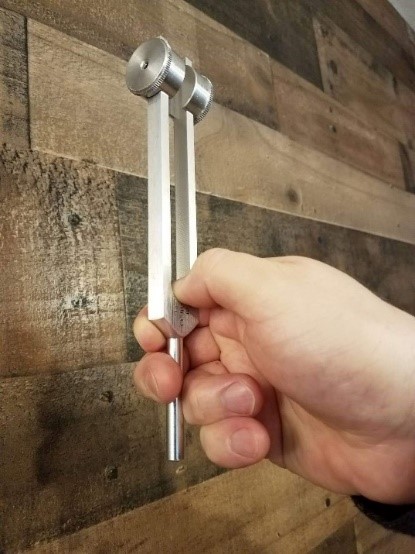
| Reduces hand fatigue and allows for use of sensing/palpation hand. Start by using the standard striking grip then transition over to finger assist grip after placing the tuning fork on the body. Use the thumb, index finger, or middle finger. Turn thumb sideways in the “U” shaped yolk if it does not fit flat. Vary your grip often to prevent fatigue. |
Butterfly Grip
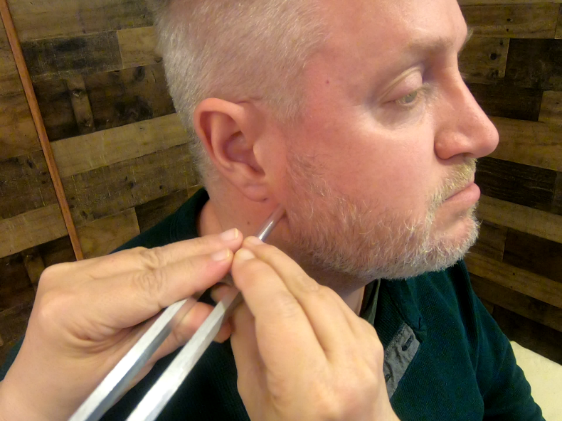
For max pressure with less grip. A butterfly grip will distribute your grip strength across both hands. Keep in mind that you do not need maximum pressure in every situation. Sometimes you might need to back off on the pressure you had with one hand when the second hand is added to the grip. The pressure more than doubles and could cause un-necessary pain in the client. This grip is designed to reduce repetitive stress, but it is used for increased pressure over a long time period like the lower back protocol. Do not use in areas where maximum pressure is not required in sensitive areas.
Strike Core Skill
The Strike Core Skill is important because the quality of a strike will affect the length and strength of the vibration for each placement. In vibrational fascia release, the release point for the cells and tissue might be at the trailing end of one specific strike that fell below the breakpoint.
Fascia collagen fibers and supporting cells require both pressure (stretch) and vibration to cause a change, and sometimes the change is the destruction (apoptosis) of the cells involved in the restriction or the release of the necessary substances to dissolve the collagen fibers responsible for the adhesion.
After our own testing and thousands of strikes, we believe that the best quality striking surface is our own body in two primary locations; the hand and knee. Body strike locations are efficient because we do not have to hold onto another object like an activator. Therefore, we can use the strike hand solely for sensing and feedback. A mastered Striking Core Skill should not hurt the therapist or leave marks. A properly executed strike has a distinct sound and feel. The key to a proper strike is the follow through of the hand holding the tuning fork. Focus a few inches beyond the point of impact so the hand continues to follow through after striking. With a proper follow-through, the weight of the tuning fork will “bounce” off the striking surface instead of controlling the exact moment of impact. In other words, it’s more of a bounce than a strike.
Hand Strike
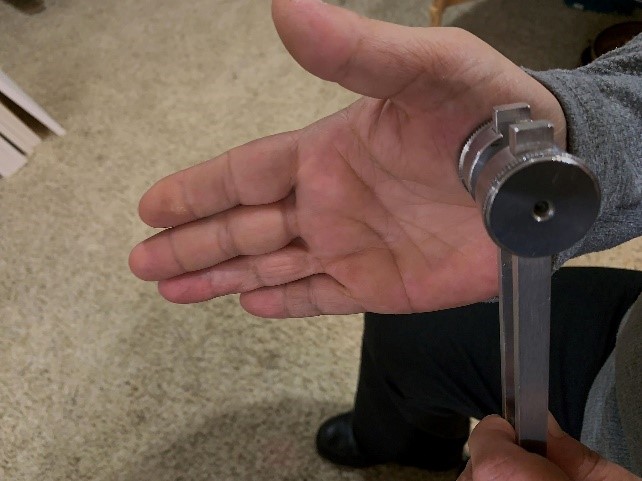
- Strike on the meaty part at the base of the palm
- Only the striking hand moves
- Strike the flat surface of the weight
- Aim for a spot beyond the striking surface
- Distinct “thump” sound
- A “tink” is okay, but a “ping” is too hard
Knee Strike
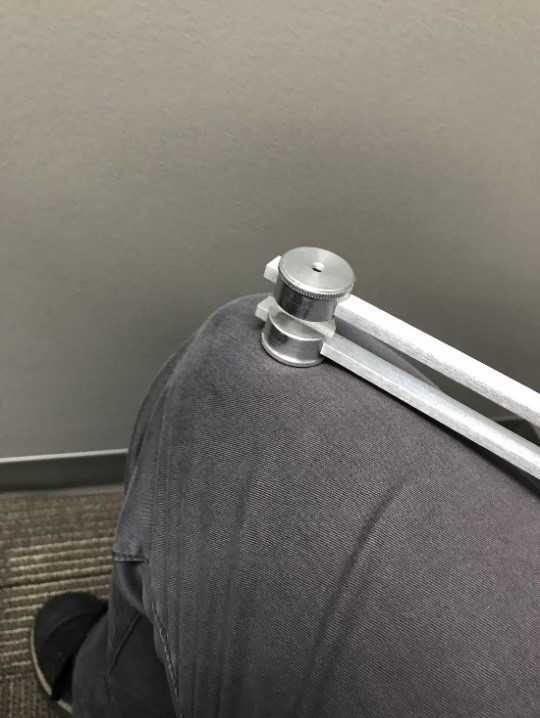
- Efficient in a sitting position
- Used when sensing hand marks a placement location
- Strike against meaty area closer to the inside of the leg where muscle is thicker
- Bend knee to tighten muscle on striking surface
- Avoid kneecap or bones
Palpation (25 mins and 14 secs):
Palpation is a skill to find the physical location on the body where we will place the tuning fork to resolve the pain or restriction. In VFRT, we use one tuning fork to allow for freedom of the opposite hand for feeling and sensing for pain and restricted fascia collagen fibers.
Our method of palpation is to press our fingers against the skin to feel for contrast between normal and abnormal tissue. This skill could take some time to master since we rarely put our hands on a person for the purpose of sensing fluids and fascial adhesions.
- Pressure provides enough compression to rise above the pain threshold
- Pressure to feel for fluid compartments and fascial restrictions
- Fluid First Followed by Fascia
Proper Palpation Provides Perfect Positioning for Pain Relief
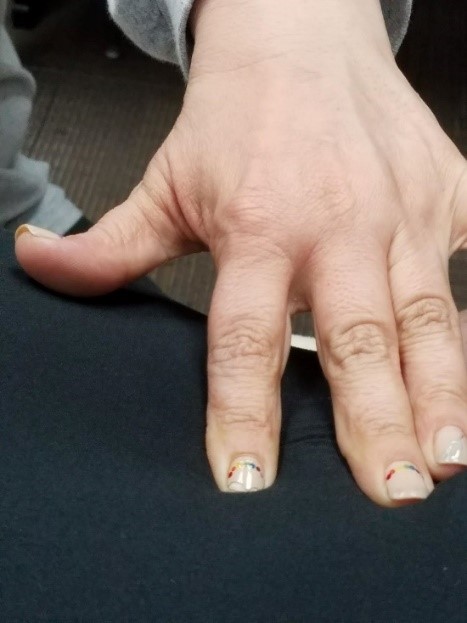
Part of the Palpation Core Skill is preparing for the placement of the tuning fork with the sensing fingers positioned where the fingernails of the first and middle finger are on either side of the placement site.
As you spread your fingers apart, continue to palpate with the pads of the fingers to locate the exact position of placement with consideration for the secondary purpose of the sensing fingers for feedback during the placement. Palpation is for perfect positioning, but it is also for effective feedback which is a skill we will discuss after the placement of the tuning fork.
Pressure (25 mins and 25 secs):
One of most difficult Core Skills to master is identifying and providing the necessary pressure required to put tension of the fascia collagen fibers underneath the skin. It is within the superficial fascia layer of extracellular matrix where most of the changes occur when we place tuning forks against the skin.
Pressure Threshold
There is a threshold of pressure that must be reached for a certain period of time before the fascia cells recognize the need for change and respond with the release of tension and associated pressure in the superficial fascia.
We will learn in the Healer Logic Core Skill that we need both stretch and vibration to cause a change in cells, tissue, and systems. When the correct pressure is reached, we need to maintain the same pressure until the threshold has been reached and the conditions change. The feedback hand is in place to determine whether we have surpassed the pressure threshold.
If the fascia layers and interstitial spaces are overfilled with fluids and pressurized to cause the lymphatic system to slow down or stop completely, the weighted tuning fork with the right pressure will change the entire gridlocked area and hopefully relieve the pressure on the nerve endings currently reporting pain. We believe the importance of rapid pain relief for many ailments lives in the pressurized, fluid-filled compartments of the superficial fascia layers.
When we have too much fluid within our interstitial spaces, the pressure of the fluids will push against the pain receptors to report pain. The act of placing a weighted tuning fork on the skin will provide even more pain depending on the level of fluid and associated pressure already present. The amount of pressure we use when placing a weighted tuning fork will be painful for some clients.
Using a cloth for a protective layer
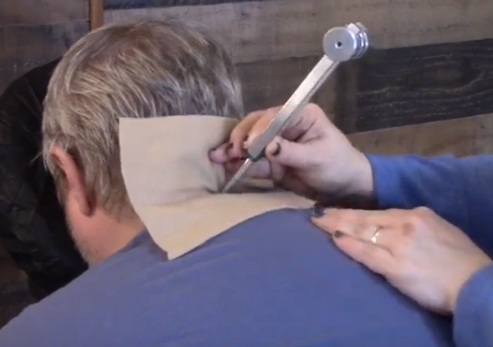
To prevent discomfort, we use the client’s own clothing or place a small square of cloth underneath tuning fork in areas where the clothing cannot be used as a protective layer. In the image above, we are using a piece of fleece we always have within arms length during the session. We also could have used the client’s shirt collar by drawing it further up the neck. However, the fleece cloth would provide a better option for working on the back side of the neck as shown in the image.
Placement (10 mins and 59 secs):
The Placement Core Skill focuses on different considerations for the location on the body and the angle of the tuning fork to maintain appropriate pressure for the tissue density in the placement location. The placement location and angle might also require the therapist to change the normal grip and pressure especially in sensitive areas.
Use hand on the other side of the body to provide stability and opposing force necessary to maintain proper pressure on the tuning fork. Clients tend to move in the opposite direction of pain and pressure, so it is not a natural action for a client to support the desired posture without the aid of a supporting hand. Applies to any location (feet, wrist, knee, shoulder) where the joint rotates and tuning fork is forcing the body part to rotate on its own.
Length and strength of a tuning fork vibration
The length of vibration for a weighted tuning fork depends on several factors including materials, length of the tines, strength and quality of strike, type of striking surface, and condition of the tissues at the location of placement. We have experienced a longer and stronger vibration from one manufacturer over another with all things being equal including frequency of the tuning fork.
Regardless of the conditions affecting the length of vibration, the one thing you can control is the quality of your strike of the tuning fork so it will vibrate longer and require fewer activations. We are working on-the-body in attempts to affect pressurized fluids and fascial adhesions, so the length of vibration for one strike can be extremely important to reach the necessary conditions to release inflammation. A good tuning fork sound healer will always focus on reaching optimum vibration in every strike and allow the vibration to run out before striking again.
If you happen to strike the tuning fork in a manner that is less than optimal, stop the vibration with your hand or leg and strike again. Avoid striking the tuning fork while it is vibrating to ensure the next strike will be correct and to prevent damaging the tines.
When it comes to strength of vibration, your body will be aware of a tuning fork that is not vibrating at full strength and your clients will also notice if something has changed. You can control the strength of a vibration by striking efficiently with sufficient force for the type of tuning fork and the surface in which you are using to activate the fork. You should always strive for maximum strength when working on-the-body to reduce inflammation.
Feedback (48 mins and 18 secs):
Client Feedback
Do not leave the client out of the feedback loop. Do not think you know more than the client about their own body. Build a rapport and encourage feedback throughout the session. The client might not know if there is suppose to be ongoing communication. Remember your Healer Logic and Session Management Skills.
Assess and re-assess often. Many times our clients will be dis-believers that their mobility can be restored and pain can be relieved in just a few minutes. Most clients have lived with this condition for years, and other methods of resolution have not worked. Be confident in your own skills. Have them test for pain and mobility so they will have confidence as well.
You are changing thought patterns and changing lives. Our most common client feedback statement is: How is this working when nothing else has? We hope that you will have the confidence to answer this question with conviction and ownership. Know our craft and why this is working when no other options provide the same resolution. When a client gives you verbal feedback of pain, this is not always your cue to stop working. The right solution might be different depending on the client and your pre-established agreement for your pain management response. Let your client know this treatment is going to hurt and why it hurts. If the client knows what to expect through dialog, they will not be surprised. Let them be a part of the session.
Sensing/Palpation Hand Feedback
Use your Palpation Skills throughout the placement. Your fingers will do the talking and provide very detailed information especially when something changes to the current condition. Refer to the video for an explanation of the bullet points below.
- Strawberries through a straw
- Push up
- Water balloon with a hole in it
- Morse code
- Change between no vibration to vibration
- Hard and tight turns to soft and squishy
- What was bumpy and lumpy is now smooth
- Cold to warm
Tuning Fork Feedback
Many of the sensing hand feedback can be felt through the tuning fork. If you are moving the base of the tuning fork with the gem foot, you can feel the tension of the fluids ahead of the fork.
In some situations, the tuning fork will slip off the placement location when a fascial adhesion releases or deflates especially with hardened nerves, tendons, ligaments, muscles, and fluid compartments.
Visual Feedback
- Color change from white to pink
- Deflation of tissue indicating fluid has been released
- Size and shape of the lump, bump, or area of focus
Release doesn’t mean resolve
Release of fascial restrictions and fluid pressure could mean it is time to re-assess, re-position, or re-focus your work on another location. A release is not going to change their lifestyle, habits, triggers, and causes that brought your client into an overwhelmed state. If your session goal was to relieve pain or increase Range of Motion, a release might be the first step in the right direction and the ultimate goal of the session.
Did it work?
The biggest part about the Feedback Skill is to know whether your VFR Technique worked and the Session Goal was reached. When you re-assess the client for mobility and relief of pain, ask them specifically “Where is the pain now?” Client feedback is not considered success if they say:
- “Hmmmm……Interesting”
- That feels a little better
- Well, you know it didn’t get there overnight
- That feels a lot better
Note: All of these reactions are considered a VFRT Failure! Re-assess and keep going.
Healer Logic (51 mins and 55 secs):
This skill refers to the logical thinking of a New Earth Vibrational Therapist as it applies to the thought process of mastering the VFRT protocols in addition to knowing:
- When to apply certain protocols to clients in a given situation
- What questions to ask the client prior to a session
- When to decline a session for the right reasons
- Why a client is in pain or restricted from normal movements
- How to respond to typical client questions during a session
- What we can resolve with VFRT protocols
- What type of session to schedule and perform
- How to establish a goal for each session
Top 4 questions from clients:
- How long will it last?
- What do I need to be doing so it doesn’t come back?
- Where does it go? (Fluid or Fat)
- How often/soon CAN or SHOULD I have this done?
Reference the video for the answers to these questions.
Most of us were born with perfect fascia
As Vibrational Therapists, we fix injuries in the fascial system using weighted tuning forks to stretch the fascia collagen fibers and vibrate and tissue to bring about a change to the current environment. Fascia and all cells need both stretch and vibration to create a change whether it is to reconfigure, produce something different, or self-destruct (apoptosis). Our cells and tissue have mechanisms for building up and tearing down. Most fascial scars beneath the skin remains in place over years because the “resolution” or clean up process was not completed. Up until the age of 15, we are capable of self-healing until our patterns change and our fascial system responds to the new normal.
Can you see or feel it?
Our VFR Technique is based on the physical science of providing mechanical vibration and pressure (stretch) in a localized area to cause a change to the cells, fluids, and tissue. In most sessions, the client is in pain or restricted in movement because of fascial scars (adhesions) and pressurized fluids.
We will learn in the next Core Skill about palpating (feeling) for both fluids and fascial adhesions. With Healer Logic, it is important to know our limitations for both a session timeframe and overall capability of the tuning fork.
Remember: The tuning fork is just a tool. You would not throw a hammer on the ground and expect it to build a house. Vibrational Therapists should look beyond the fork and understand enough biology to set realistic expectations with established limitations. Our actions and mastery of our skills are a vital part of the healing process. Although we may have limitations on what we can influence, we can still work on the symptoms of a given condition or ailment.
Things we cannot directly influence with weighted tuning forks:
- Medical modifications or alterations
- Birth or developmental defects
- Learning disabilities
- Behavioral/cognitive/psychological diagnosis
Goal of Session:
With Healer Logic, we are responsible for Session Management in knowing what type of session the client requires and plan the session according to a specific order of priority. Set expectations at the beginning of the session, talk to the client about what you are doing during the session, and set expectations about what the client can expect after the session (see Resolution and Accountability Core Skill)
1. Danger or Risk of:
- Falling (Mobility)
- Heart attack
- Stroke
- Breathing
2. Pain Relief
3. Range of Motion (ROM)
4. Quality of Life (QOL): “Pretty and Pain Free”
5. Triggers and Causes
- Re-occurrence = no lifestyle change = chronic
- Allergies: Environment and Food
- Medical Modifications or Alterations
- Body Patterns (posture, sleeping, sitting)
Power Session vs. Therapy Session
Therapy is where you go through steps to get better. Maintenance is where you schedule sessions to maintain the current state. As we move through the order of priority for Session Management, there are two main types of sessions to clearly establish an expectation.
Power Sessions are typically 45 minutes or less with a focus on a specific area of pain or restriction. Our clients are paying us for an expected goal. Establish the goal and work towards 100% resolution. Avoid working on many ailments within a session without an established goal. Laundry List clients require your Healer Logic and Session Management skills to control the session and provide relief and resolution to the established goal even if it only takes 10-15 minutes.
Therapy Sessions are on-going treatments with an established goal. Some clients have long-term triggers and causes requiring several sessions to re-train the cells, fascia, and systems into a new normal. If the trigger is still in place, our Therapy Sessions should be providing more relief than the damage the trigger is causing.
For permanent causes like medical alterations, our sessions might last for the lifetime of the client at greater intervals (every other week, once a month) to maintain Quality of Life. Clients who have had their lymph nodes removed are an example of long-term sessions to remove or move the interstitial fluids in the absence of functioning local lymphatic vessels and nodes.
Press and Push (44 mins and 07 secs):
- Used for interstitial fluid movement
- Reduces session time
- Increases ability to find fascial scars or restrictions
- Toxin Containment/Quarantine
- Proper pressure
- Let the fingers sink
- Press forward slowly: Tension release controls the speed
- Keep the fluids ahead of the fingers
- Follow through with the push to a “Safe Zone”
Gem Foot Slide:
Gem Foot Slide Core Skill
- Same concepts apply from the Press and Push Core Skill
- Less efficient than Press and Push (finger feedback)
- When a therapist cannot use their hands to press against the skin
- Alternative to using the Press and Push
- Using the right tuning fork extension
- Used in sensitive areas of the body
- Maintain angle awareness since the edge of the gem foot could scrape against the skin
Gem Foot Attachments
- Crystal type (any type will work)
- 6mm Trigger Point (avoid using during a fluid push)
- 15mm (smaller or confined areas)
- 25mm (larger areas and longer distance)
Resolution and Accountability (33 mins 17 secs):
- Knowing when you are done with the session
- Fully resolving the issue
- Re-assess and ask the right questions
- “Where does it hurt now?”
- Re-enforcing expectations
- Controlling the session
- Dealing with “talkers”
- Laundry List Clients
- Working on too many conditions
- If it’s not first session resolution, it’s considered therapy
- Chasing the Pain
- “Jack of all trades and master of none”
- Adding modalities
- Blaming the client
- Giving the Client Homework
